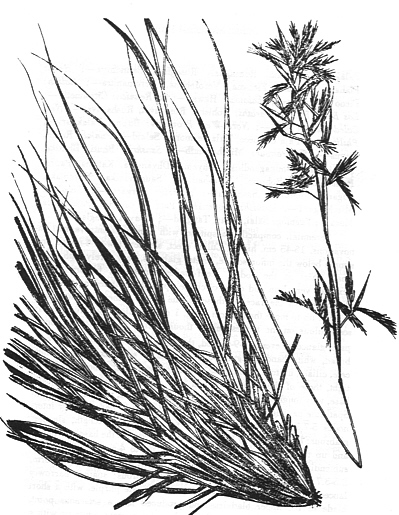

Zitierweise / cite as:
Carakasaṃhitā: Ausgewählte Texte aus der Carakasaṃhitā / übersetzt und erläutert von Alois Payer <1944 - >. -- Anhang A: Pflanzenbeschreibungen. -- Cymbopogon schoenanthus (L.) Spreng. -- Fassung vom 2007-06-27. -- URL: http://www.payer.de/ayurveda/pflanzen/cymbopogon_schoenanthus.htm
Erstmals publiziert: 2007-06-27
Überarbeitungen:
Anlass: Lehrveranstaltung SS 2007
©opyright: Dieser Text steht der Allgemeinheit zur Verfügung. Eine Verwertung in Publikationen, die über übliche Zitate hinausgeht, bedarf der ausdrücklichen Genehmigung des Verfassers
Dieser Text ist Teil der Abteilung Sanskrit von Tüpfli's Global Village Library
WARNUNG: dies ist der Versuch einer
Übersetzung und Interpretation eines altindischen Textes. Es ist keine
medizinische Anleitung. Vor dem Gebrauch aller hier genannten Heilmittel wird
darum ausdrücklich gewarnt. Nur ein erfahrener, gut ausgebildeter ayurvedischer
Arzt kann Verschreibungen und Behandlungen machen!
Falls Sie die diakritischen Zeichen nicht dargestellt bekommen, installieren Sie eine Schrift mit Diakritika wie z.B. Tahoma.
Verwendete und zitierte Werke siehe: http://www.payer.de/ayurveda/caraka0001.htm

Abb.: Cymbopogon schoenanthus
(L.) Spreng.
[Bildquelle: Kirtikar-Basu, ©1918]
Drury:
"Andropogon citratum (Dec.) N. O. Graminaceae
- Lemon-grass, Eng.
- Akya ghas, Hind.
- Hazar-masaleh, Duk.
- Vashanap-pullu,
- Karpura-pullu, Tam,
- Nimma-gaddi, Chippa-gaddi, Tel.
- Vasanap-pulla, Samb-hara-pulla, Mal.
- Agya-ghans, Beng.
Description.—Root perennial; panicles somewhat secund; spikes conjugate, ovate-oblong; rachis pubescent; floscules sessile, awnless; culms 5-7 feet, erect, smooth; leaves many near the root, bifarious, soft, pale green, 3-4 feet long; spike-lets in pairs, on a common pedicel furnished with a spathe; rachis articulated, hairy; flowers in pairs, one hermaphrodite and sessile, the other male and pedicelled.—Rheede, xii t. 72. —A. schoenanthus, Linn.—Roxb. Fl. Ind. i. 274.—Cymbopogon schoenanthus, Spreng.-------Travancore. Bengal. Cultivated in CoromandeL
Medical Uses.—An infusion of the fragrant leaves, which are bitter and aromatic, is given to children as an excellent stomachic. It is also diaphoretic. An essential oil is prepared from them, which is a most valuable remedy in rheumatism, applied externally. Mixed with butter-milk, the leaves are used in cases of ringworm. It is a remedy of considerable value in affections of the bowels. It allays and arrests vomiting in cholera, and aids the process of reaction. Externally applied, it forms a useful embrocation in chronic rheumatism, neuralgia, sprains, and similar painful affections.— (Pharm. of India.) The rhizomes and flowers have similar qualities.— Lindley. The essential oil, when first distilled, is of a high colour, owing to the quantity of resin in it. To remove this, as also to have the oil clear, it is saturated in charcoal grits that have been previously well washed and thoroughly dried. The grits saturated with the oil are thrown into the still with the required quantity of water, made slightly sharp to the taste and distilled. The oil thus obtained is not only clear, but in a great measure free from resin, and this passes in England as essence of Verbena or Citronelle. The oil of the first distilling, which is of a high colour, is known as the Lemon-grass oil. Mr C. Kohlhoff, for some time Conservator of Forests in Travancore, has used the double-distilled oil as an embrocation in cases of rheumatism, and found it a most efficacious remedy, and has also administered it in cases of cholera with great advantage. The dose is from 12 to 20 drops on a lump of sugar, repeated till the symptoms abate, at the same time applying it externally to the lips, back, and stomach, to prevent the cold and cramp so invariably accompanying that disorder. A decoction made from the fresh leaves is used by the natives to allay thirst in various disorders,— Pers. Obs.
Economic Uses—When fresh and young, the leaves are used in many parts of the country as a substitute for tea, and the white centre of the succulent leaf-culms is used to impart a flavour to curries. In Bengal, largo tracts of waste land are covered with this grass. The export of Lemon-grass oil from Ceylon amounts in value to nearly £7000 annually.—Roxb. Simmonds."
[Quelle: Drury, Heber <1819 - 1872>: The useful plants of India : with notices of their chief value in commerce, medicine, and the arts. -- 2d ed. with additions and corrections. London : Allen, 1873. -- xvi, 512 p. ; 22 cm. -- s.v.]
Dutt:
"ANDROPOGON SCHOENANTHUS, Linn. Sans. Bhūstrina, Vern. Gandha benā, Beng. ANDROPOGON IWARANCUSA, Roxb. Sans. Lā
majjaka. Vern. Lāmjak, Hind. Karankusā, Beng.These two fragrant grasses are occasionally used as aromatics and refrigerants like the roots of Andropogon muricatus. A. schoenanthus is common in Bengal, being cultivated in gardens for the sake of its fragrant leaves. A. Iwarancusa is "a native of the skirts of the Northern mountains of India." Its virtues seem to reside in the larger roots marked with annular cicatrices."
[Quelle: Dutt, Uday Chand: The materia medica of the Hindus / Uday Chand Dutt. With a glossary of Indian plants by George King. -- 2. ed. with additions and alterations / by Binod Lall Sen & Ashutosh Sen. -- Calcutta, 1900. - XVIII, 356 S. -- S. 271.]